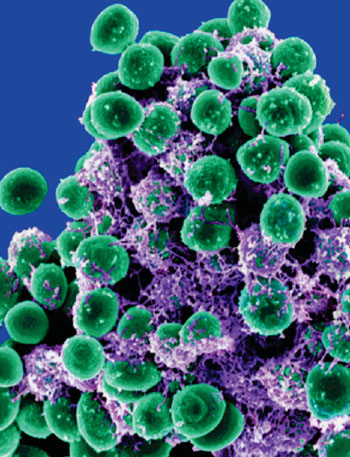Discarded Blood Tests May Offer Life-Saving Information
By LabMedica International staff writers
Posted on 08 Sep 2014
Blood culture isolates are the cornerstone of adequate antibiotic treatment, but many blood cultures are contaminated with bacteria residing on the skin, and the most common contaminants are coagulase-negative staphylococci (CoNS).Posted on 08 Sep 2014
Such contaminated cultures are mostly disregarded and discarded but in fact these contaminated cultures contain diagnostic information such as the antibiotic resistance profiles of CoNS contaminants and those of the actual infecting bacteria isolated subsequently from the same patient.

Image: Scanning electron micrograph of Staphylococcus epidermidis, the commonest coagulase-negative staphylococci found on the skin (Photo courtesy of the US National Institute of Allergy and Infectious Diseases).
Clinical scientists at the Sackler Faculty of Medicine (Tel Aviv, Israel) conducted a retrospective study on patients with positive blood cultures from 2009 to 2012. Data included patient demographics, hospitalization records, comorbidities, blood culture results and date of death. The cohort consisted of 2,518 patients with 5,290 blood cultures, where 1,124 patients had 1,664 blood cultures with CoNS contaminants.
High overall CoNS resistance predicted high overall resistance of the subsequent bacterial isolates for Gram-positive and Gram-negative bacteria. The resistance of CoNS contaminants to a specific antibiotic predicted the resistance of the subsequent bacterial isolates to that antibiotic and highly resistant CoNS isolates were associated with higher short-term mortality.
The team noted that most hospital patients are treated at the outset with broad spectrum antibiotics. Days later, after initial test results are known, clinicians replace broad spectrum antibiotics with more precise narrow-spectrum antibiotics, which treat the specific bacteria identified by the blood sample. Narrow spectrum antibiotics are better for the body because they target specific bacteria as opposed to an entire microenvironment. Moreover, broad spectrum antibiotics might result in altered bacterial environments of the skin and gastro-intestinal tract, promoting inflammation and the emergence of resistant pathogens.
Gideon Y Stein, MD, PhD, a lead author of the study said, “Because we have found a direct correlation between resistance profiles of CoNS contaminants and those of the actual infecting bacteria isolated from the same patient, the results of these “junk” samples can be used to predict patient mortality and correct empirical antibiotic therapy. This should serve as an additional, noninvasive, diagnostic tool.” The study was published in the September issue of the Journal of Antimicrobial Chemotherapy.
Related Links:
Tel Aviv University Sackler Faculty of Medicine








 (3) (1).png)




